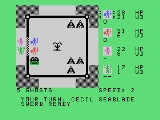
Tunnels of Doom
Encyclopedia

The game is one of the first graphical computer role-playing games (CRPGs). Based loosely on the paper-and-pencil role-playing game
Role-playing game (pen and paper)
A tabletop role-playing game, pen-and-paper role-playing game, or Table-talk role-playing game is a form of role-playing game in which the participants describe their characters' actions through speech...
Dungeons & Dragons
Dungeons & Dragons
Dungeons & Dragons is a fantasy role-playing game originally designed by Gary Gygax and Dave Arneson, and first published in 1974 by Tactical Studies Rules, Inc. . The game has been published by Wizards of the Coast since 1997...
, it is a standard dungeon crawl
Dungeon crawl
A dungeon crawl is a type of scenario in fantasy role-playing games in which heroes navigate a labyrinthine environment, battling various monsters, and looting any treasure they may find...
adventure in which a player or number of players controls the fates of 1–4 characters as they journey into the depths of the Tunnels of Doom. Despite the lack of a progressive storyline, it possesses many elements duplicated by other, later CRPGs.
The features of the game include:
- Control of up to 4 characters, renamed to the players' wishes. Alternatively, four players could each control a character during the combat encounters.
- Four character classes — fighter, rogue, wizard for games started with 2–4 characters, while the "hero" class is also available for games starting with one character only.
- An encounter area that uses turn-based combat sequences.
- A dungeon crawl through various dungeon rooms in 3D, with an auto-map display.
- A display of all of the characters' health and damage which can be monitored in combat.
- A variety of monsters which grow progressively more difficult as the characters move through the dungeon.
- The ability to listen for monsters at a door before deciding to open it.
- Random encounters with monsters.
- A variety of weapons and armor purchased at stores within the dungeon or picked up as treasure.
- A variety of magical treasures, which the players must figure out how to use.
- Characters that are killed remain part of the group, and will eventually come back to good health as long as at least one party member remains alive. Dead characters can still perform (or be made to perform) certain tasks including holding weapons and drinking from fountains.
- Fountains on each level. Characters can drink from fountains. The 'water' can increase or decrease a players total hit points, health, luck, etc.
- Three difficulty levels, 1-10 floors. The higher the floor and difficulty, the more powerful the creatures.
- A lost king and his orb. Find the king and his orb and return them to the surface to win. Both the king and orb have to be found within a certain number of turns, or they will be destroyed. Once the king is found, the players will be attacked in the hallways by wandering creatures. Also included is an 'easy' quest called 'Pennies and Prizes', with no monsters or traps.
The music for Tunnels of Doom was composed by Hank Mishkoff, a TI programmer who also wrote the music for the TI-99/4 Demonstration program and other early TI-99/4 programs. Mishkoff originally created the music for The Attack, an earlier program; however, TI rejected the composition for that game, using it with Tunnels of Doom instead.
In 2008, Howard Kistler of DreamCodex developed a revised version of the game, which he called Tunnels of Doom Reboot, that featured music by German composer Frank Scheffel.

